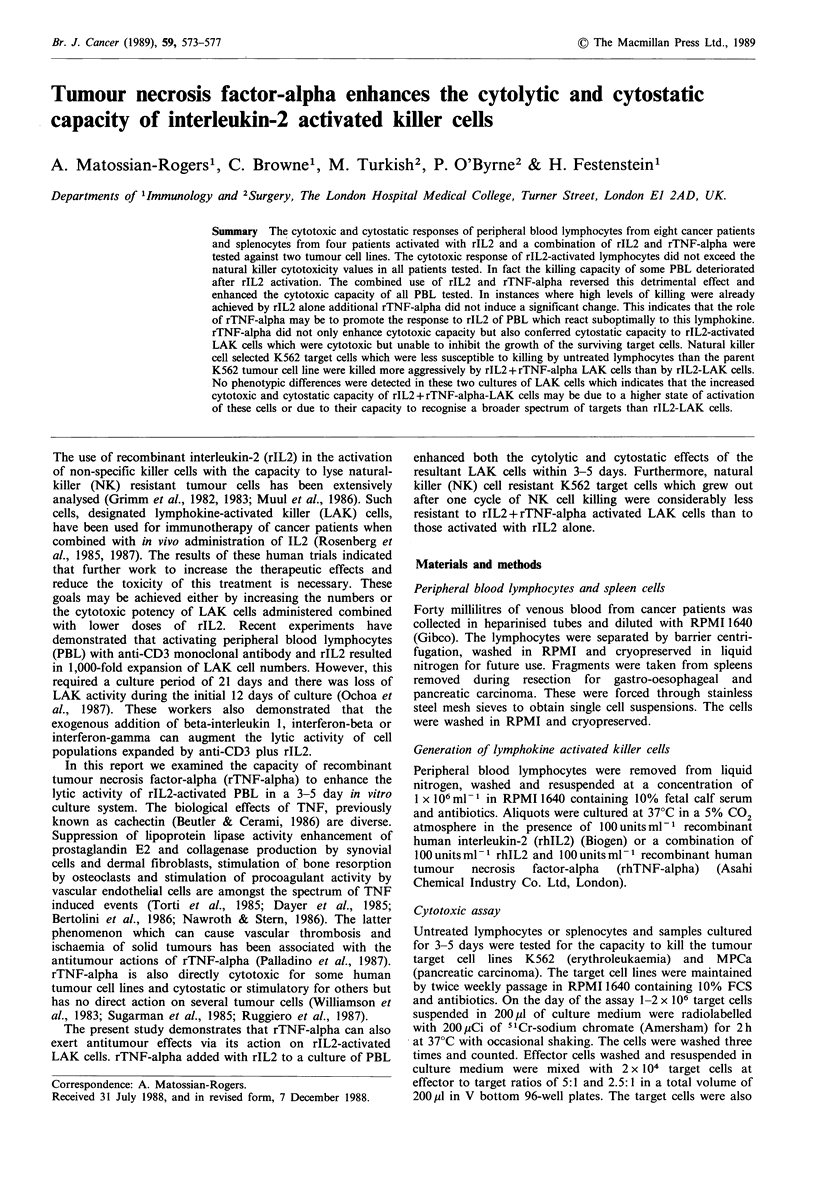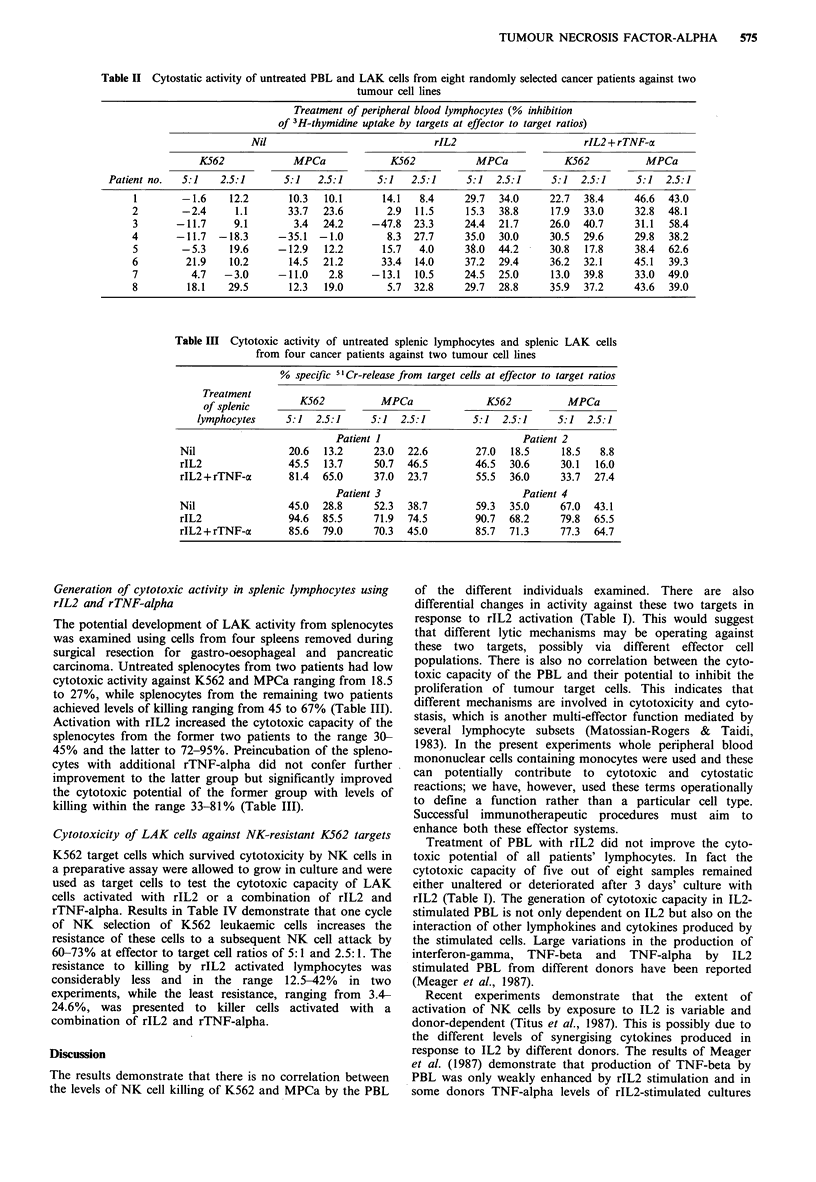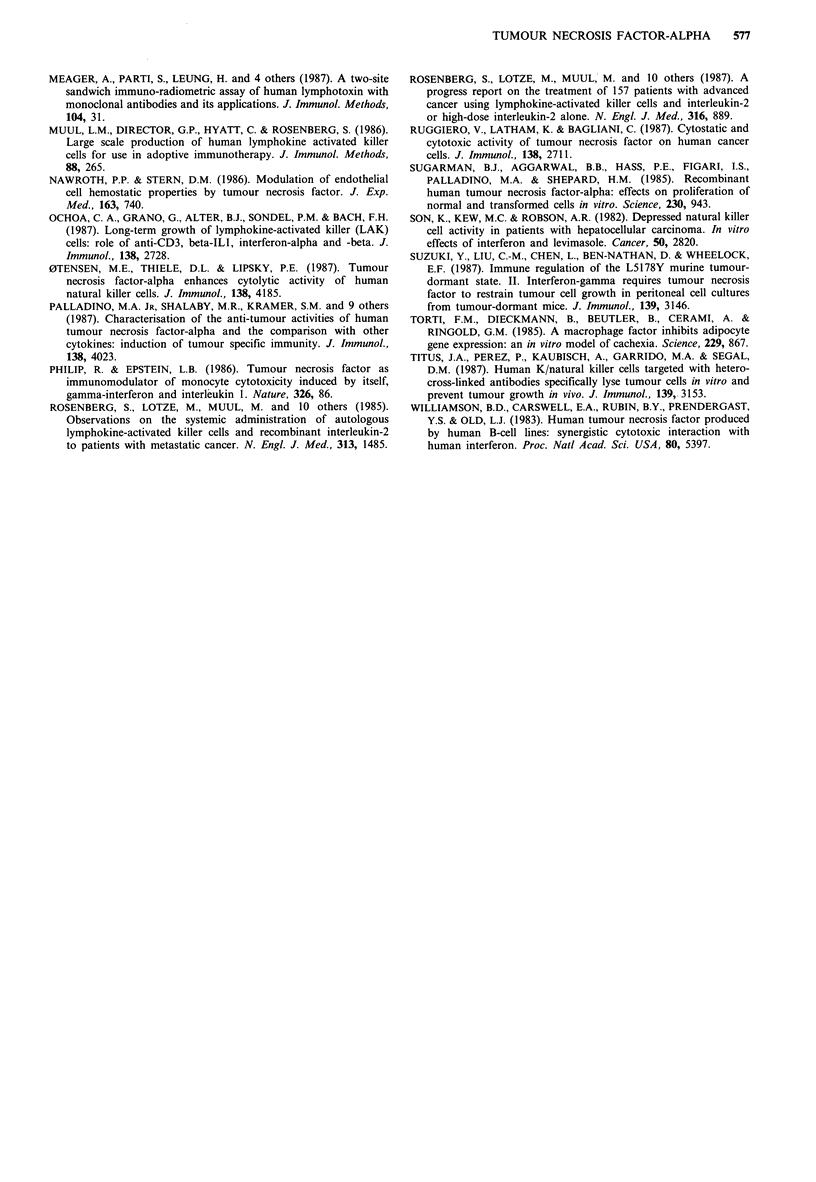Abstract
The cytotoxic and cytostatic responses of peripheral blood lymphocytes from eight cancer patients and splenocytes from four patients activated with rIL2 and a combination of rIL2 and rTNF-alpha were tested against two tumour cell lines. The cytotoxic response of rIL2-activated lymphocytes did not exceed the natural killer cytotoxicity values in all patients tested. In fact the killing capacity of some PBL deteriorated after rIL2 activation. The combined use of rIL2 and rTNF-alpha reversed this detrimental effect and enhanced the cytotoxic capacity of all PBL tested. In instances where high levels of killing were already achieved by rIL2 alone additional rTNF-alpha did not induce a significant change. This indicates that the role of rTNF-alpha may be to promote the response to rIL2 of PBL which react suboptimally to this lymphokine. rTNF-alpha did not only enhance cytotoxic capacity but also conferred cytostatic capacity to rIL2-activated LAK cells which were cytotoxic but unable to inhibit the growth of the surviving target cells. Natural killer cell selected K562 target cells which were less susceptible to killing by untreated lymphocytes than the parent K562 tumour cell line were killed more aggressively by rIL2 + rTNF-alpha LAK cells than by rIL2-LAK cells. No phenotypic differences were detected in these two cultures of LAK cells which indicates that the increased cytotoxic and cytostatic capacity of rIL2 + rTNF-alpha-LAK cells may be due to a higher state of activation of these cells or due to their capacity to recognise a broader spectrum of targets than rIL2-LAK cells.
Full text
PDF




Selected References
These references are in PubMed. This may not be the complete list of references from this article.
- Bertolini D. R., Nedwin G. E., Bringman T. S., Smith D. D., Mundy G. R. Stimulation of bone resorption and inhibition of bone formation in vitro by human tumour necrosis factors. Nature. 1986 Feb 6;319(6053):516–518. doi: 10.1038/319516a0. [DOI] [PubMed] [Google Scholar]
- Beutler B., Cerami A. Cachectin and tumour necrosis factor as two sides of the same biological coin. Nature. 1986 Apr 17;320(6063):584–588. doi: 10.1038/320584a0. [DOI] [PubMed] [Google Scholar]
- Dayer J. M., Beutler B., Cerami A. Cachectin/tumor necrosis factor stimulates collagenase and prostaglandin E2 production by human synovial cells and dermal fibroblasts. J Exp Med. 1985 Dec 1;162(6):2163–2168. doi: 10.1084/jem.162.6.2163. [DOI] [PMC free article] [PubMed] [Google Scholar]
- Dinarello C. A., Cannon J. G., Wolff S. M., Bernheim H. A., Beutler B., Cerami A., Figari I. S., Palladino M. A., Jr, O'Connor J. V. Tumor necrosis factor (cachectin) is an endogenous pyrogen and induces production of interleukin 1. J Exp Med. 1986 Jun 1;163(6):1433–1450. doi: 10.1084/jem.163.6.1433. [DOI] [PMC free article] [PubMed] [Google Scholar]
- Grimm E. A., Mazumder A., Zhang H. Z., Rosenberg S. A. Lymphokine-activated killer cell phenomenon. Lysis of natural killer-resistant fresh solid tumor cells by interleukin 2-activated autologous human peripheral blood lymphocytes. J Exp Med. 1982 Jun 1;155(6):1823–1841. doi: 10.1084/jem.155.6.1823. [DOI] [PMC free article] [PubMed] [Google Scholar]
- Grimm E. A., Robb R. J., Roth J. A., Neckers L. M., Lachman L. B., Wilson D. J., Rosenberg S. A. Lymphokine-activated killer cell phenomenon. III. Evidence that IL-2 is sufficient for direct activation of peripheral blood lymphocytes into lymphokine-activated killer cells. J Exp Med. 1983 Oct 1;158(4):1356–1361. doi: 10.1084/jem.158.4.1356. [DOI] [PMC free article] [PubMed] [Google Scholar]
- Herman J., Dinarello C. A., Kew M. C., Rabson A. R. The role of interleukin 1 (IL 1) in tumor-NK cell interactions: correction of defective NK cell activity in cancer patients by treating target cells with IL 1. J Immunol. 1985 Oct;135(4):2882–2886. [PubMed] [Google Scholar]
- Herman J., Kew M. C., Rabson A. R. Defective interleukin-1 production by monocytes from patients with malignant disease. Interferon increases IL-1 production. Cancer Immunol Immunother. 1984;16(3):182–185. doi: 10.1007/BF00205426. [DOI] [PMC free article] [PubMed] [Google Scholar]
- Matossian-Rogers A., Taidi B. Characterization of cytostatic effector lymphocytes during the development of a syngeneic lymphosarcoma in C3H mice: use of monoclonal reagents to identify T-cell subsets. Cell Immunol. 1983 Dec;82(2):292–307. doi: 10.1016/0008-8749(83)90163-6. [DOI] [PubMed] [Google Scholar]
- Muul L. M., Director E. P., Hyatt C. L., Rosenberg S. A. Large scale production of human lymphokine activated killer cells for use in adoptive immunotherapy. J Immunol Methods. 1986 Apr 17;88(2):265–275. doi: 10.1016/0022-1759(86)90015-3. [DOI] [PubMed] [Google Scholar]
- Nawroth P. P., Stern D. M. Modulation of endothelial cell hemostatic properties by tumor necrosis factor. J Exp Med. 1986 Mar 1;163(3):740–745. doi: 10.1084/jem.163.3.740. [DOI] [PMC free article] [PubMed] [Google Scholar]
- Ochoa A. C., Gromo G., Alter B. J., Sondel P. M., Bach F. H. Long-term growth of lymphokine-activated killer (LAK) cells: role of anti-CD3, beta-IL 1, interferon-gamma and -beta. J Immunol. 1987 Apr 15;138(8):2728–2733. [PubMed] [Google Scholar]
- Ostensen M. E., Thiele D. L., Lipsky P. E. Tumor necrosis factor-alpha enhances cytolytic activity of human natural killer cells. J Immunol. 1987 Jun 15;138(12):4185–4191. [PubMed] [Google Scholar]
- Palladino M. A., Jr, Shalaby M. R., Kramer S. M., Ferraiolo B. L., Baughman R. A., Deleo A. B., Crase D., Marafino B., Aggarwal B. B., Figari I. S. Characterization of the antitumor activities of human tumor necrosis factor-alpha and the comparison with other cytokines: induction of tumor-specific immunity. J Immunol. 1987 Jun 1;138(11):4023–4032. [PubMed] [Google Scholar]
- Philip R., Epstein L. B. Tumour necrosis factor as immunomodulator and mediator of monocyte cytotoxicity induced by itself, gamma-interferon and interleukin-1. Nature. 1986 Sep 4;323(6083):86–89. doi: 10.1038/323086a0. [DOI] [PubMed] [Google Scholar]
- Rosenberg S. A., Lotze M. T., Muul L. M., Chang A. E., Avis F. P., Leitman S., Linehan W. M., Robertson C. N., Lee R. E., Rubin J. T. A progress report on the treatment of 157 patients with advanced cancer using lymphokine-activated killer cells and interleukin-2 or high-dose interleukin-2 alone. N Engl J Med. 1987 Apr 9;316(15):889–897. doi: 10.1056/NEJM198704093161501. [DOI] [PubMed] [Google Scholar]
- Rosenberg S. A., Lotze M. T., Muul L. M., Leitman S., Chang A. E., Ettinghausen S. E., Matory Y. L., Skibber J. M., Shiloni E., Vetto J. T. Observations on the systemic administration of autologous lymphokine-activated killer cells and recombinant interleukin-2 to patients with metastatic cancer. N Engl J Med. 1985 Dec 5;313(23):1485–1492. doi: 10.1056/NEJM198512053132327. [DOI] [PubMed] [Google Scholar]
- Ruggiero V., Latham K., Baglioni C. Cytostatic and cytotoxic activity of tumor necrosis factor on human cancer cells. J Immunol. 1987 Apr 15;138(8):2711–2717. [PubMed] [Google Scholar]
- Son K., Kew M., Rabson A. R. Depressed natural killer cell activity in patients with hepatocellular carcinoma. In vitro effects of interferon and levamisole. Cancer. 1982 Dec 15;50(12):2820–2825. doi: 10.1002/1097-0142(19821215)50:12<2820::aid-cncr2820501222>3.0.co;2-#. [DOI] [PubMed] [Google Scholar]
- Sugarman B. J., Aggarwal B. B., Hass P. E., Figari I. S., Palladino M. A., Jr, Shepard H. M. Recombinant human tumor necrosis factor-alpha: effects on proliferation of normal and transformed cells in vitro. Science. 1985 Nov 22;230(4728):943–945. doi: 10.1126/science.3933111. [DOI] [PubMed] [Google Scholar]
- Suzuki Y., Liu C. M., Chen L. P., Ben-Nathan D., Wheelock E. F. Immune regulation of the L5178Y murine tumor-dormant state. II. Interferon-gamma requires tumor necrosis factor to restrain tumor cell growth in peritoneal cell cultures from tumor-dormant mice. J Immunol. 1987 Nov 1;139(9):3146–3152. [PubMed] [Google Scholar]
- Titus J. A., Perez P., Kaubisch A., Garrido M. A., Segal D. M. Human K/natural killer cells targeted with hetero-cross-linked antibodies specifically lyse tumor cells in vitro and prevent tumor growth in vivo. J Immunol. 1987 Nov 1;139(9):3153–3158. [PubMed] [Google Scholar]
- Torti F. M., Dieckmann B., Beutler B., Cerami A., Ringold G. M. A macrophage factor inhibits adipocyte gene expression: an in vitro model of cachexia. Science. 1985 Aug 30;229(4716):867–869. doi: 10.1126/science.3839597. [DOI] [PubMed] [Google Scholar]
- Williamson B. D., Carswell E. A., Rubin B. Y., Prendergast J. S., Old L. J. Human tumor necrosis factor produced by human B-cell lines: synergistic cytotoxic interaction with human interferon. Proc Natl Acad Sci U S A. 1983 Sep;80(17):5397–5401. doi: 10.1073/pnas.80.17.5397. [DOI] [PMC free article] [PubMed] [Google Scholar]


